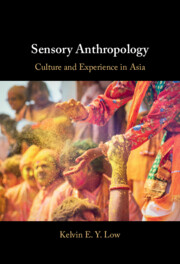Introduction: How the Senses Are Good to Think With
Published online by Cambridge University Press: 02 March 2023
Summary
What does an anthropology of the senses entail? How can one reconstruct writings and knowledge about Asia through the lens of the senses using anthropological analysis? What part do the senses play in everyday life in Asia across a variety of historical and contemporary contexts – stretching from the pre- to postcolonial and including the transnational? How are the senses connected to a range of everyday life domains that comprise religion, morality, foodways, music, linguistic practices, local–foreign interactions, and the migratory and economic movements of social actors and commodities? How might one develop theoretical argumentation and delineate interdisciplinary and comparative possibilities to analyse sensory cultures? The introductory chapter opens the book by putting forward these core queries that set the stage for subsequent chapters. Apart from charting the field of sensory anthropology, I explain why and how a sensory history of Asia that attends to a wide and non-exhaustive range of sensory cultures is important. I engage with current anthropological scholarship and others that focus in the main on Western cultures or non-industrial societies. I show how this book takes on theoretical, comparative and contextual commitments as key inquiries in articulating the social life of the senses in Asia.
Keywords
- Type
- Chapter
- Information
- Sensory AnthropologyCulture and Experience in Asia, pp. 1 - 16Publisher: Cambridge University PressPrint publication year: 2023



